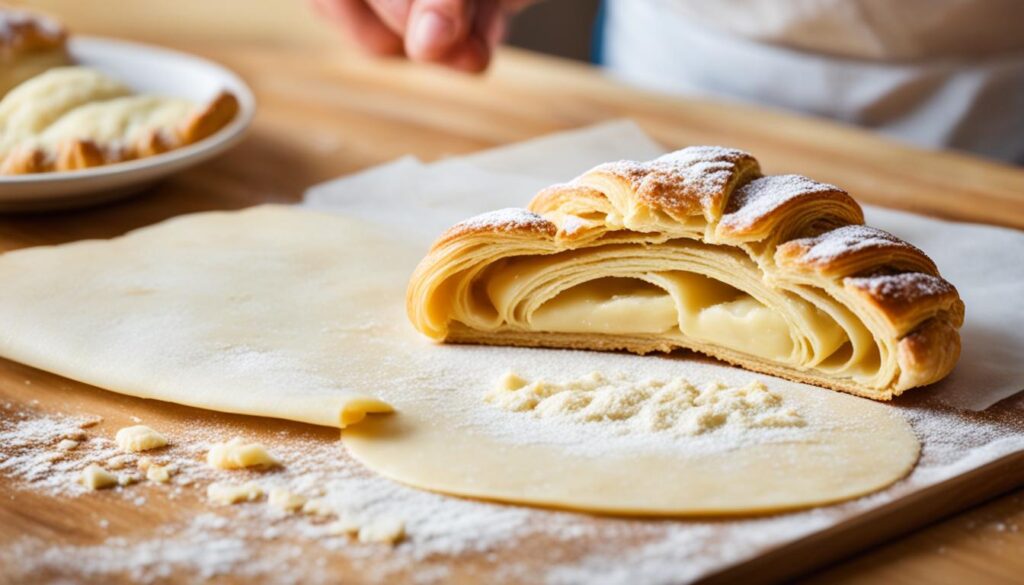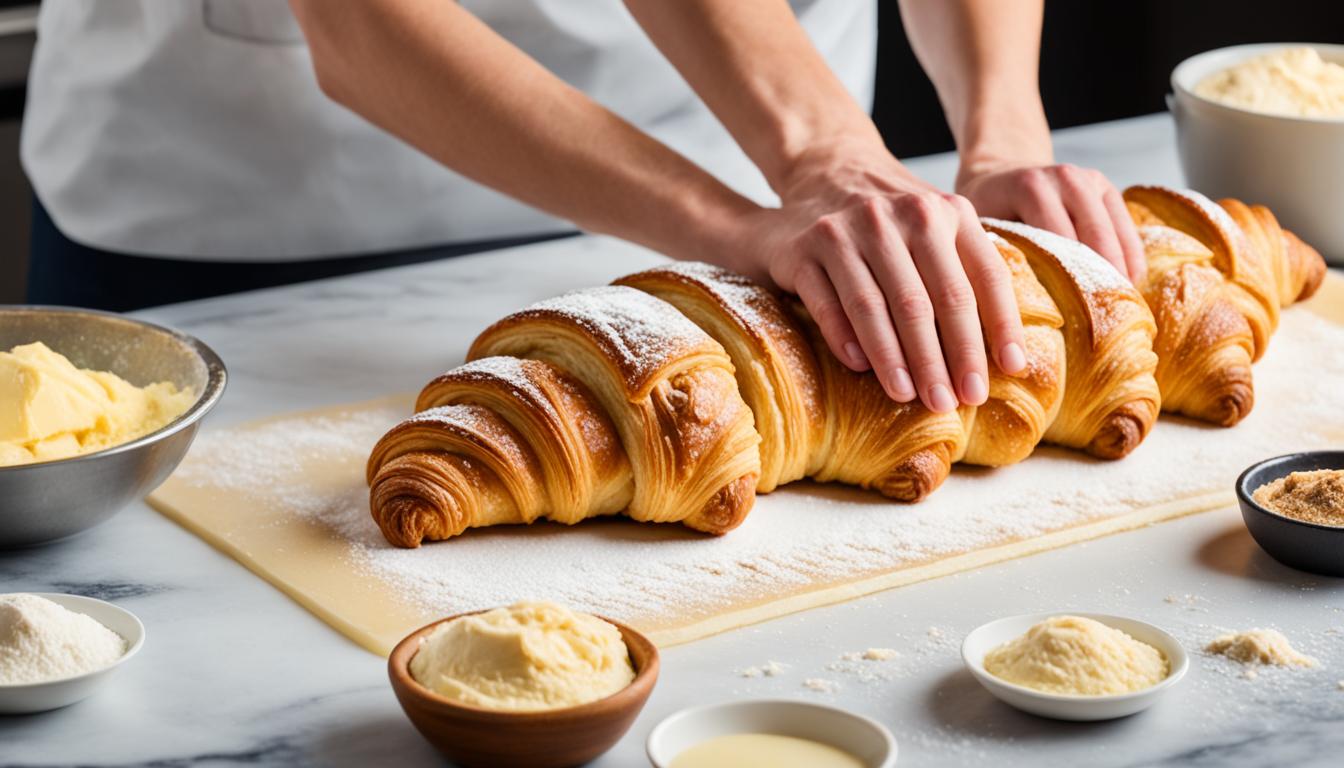Are you ready to embark on a culinary journey to the heart of French pastry? In this article, we will guide you through the art of making traditional French croissants from scratch in the comfort of your own kitchen. Get ready to impress your friends and family with this homemade croissant recipe.
With our step-by-step instructions and expert tips, you’ll learn how to create perfectly flaky and buttery croissants. Whether you’re a novice baker or an experienced home cook, this guide will help you master the craft of crafting this iconic pastry.
Forget store-bought croissants and dive into the world of homemade goodness. Let’s start this culinary adventure and discover the secrets behind the perfect croissant dough and lamination techniques. Get ready to indulge in the heavenly aroma and delicious taste of your very own homemade croissants.
The Secrets to a Flaky Pastry
The key to achieving a flaky pastry lies in the laminated dough. This involves folding layers of butter into the dough, creating a light and airy texture. By following proper french pastry techniques, you can master the art of making perfectly flaky croissants at home.
To create the laminated dough for croissants, start with a rich and flavorful croissant dough. This dough is made by combining flour, yeast, sugar, salt, and water. It is then kneaded until it forms a soft, elastic dough.
Once the dough is ready, it’s time to incorporate the butter. Roll out the dough into a rectangle and place a block of chilled butter in the center. Fold the dough over the butter, sealing the edges tightly. This step is crucial for achieving those beautiful layers in the final pastry.
After sealing the dough, it’s time to start the lamination process. This involves rolling out the dough and folding it into layers. By repeating this process several times, you create numerous layers of butter and dough that will result in a flaky and delicate pastry.
Each time you roll out the dough, be sure to dust it lightly with flour to prevent it from sticking. Use gentle, even pressure while rolling to maintain an even thickness. After each roll, carefully fold the dough into thirds, creating a compact package. This allows the dough to rest and relax before the next rolling and folding.
For the best results, refrigerate the dough between each lamination fold. This helps the butter to solidify and maintain its distinct layers. It also allows the gluten in the dough to relax, resulting in a tender and flaky texture.
Continue this process of rolling, folding, and chilling until you have completed several laminations. The number of folds will depend on the recipe and desired level of flakiness. Typically, croissant dough undergoes three to four laminations.
Once the laminations are complete, the dough is ready to be shaped into croissants. Roll out the dough into a large rectangle, then cut it into triangles. Gently stretch each triangle and roll it up tightly, starting from the wide end. This creates the signature crescent shape of croissants.
Place the shaped croissants on a baking sheet lined with parchment paper and let them proof until they double in size. This usually takes around 2-3 hours. Brush the croissants with an egg wash before baking to achieve a golden, shiny crust.
Preheat your oven and bake the croissants to perfection. As they bake, the layers of butter will melt and create those airy pockets that make croissants so irresistible. The result is a flaky and buttery pastry that is perfect for breakfast or any time you want to indulge in a delicious treat.
Mastering the art of laminating dough is essential for creating the perfect croissants. It takes practice and patience, but the end result is well worth the effort. So, roll up your sleeves, gather your ingredients, and get ready to impress your taste buds with homemade flaky croissants.
The Art of Lamination
In order to achieve the flaky and buttery texture that makes croissants so irresistible, mastering the art of lamination is crucial. Lamination is the process of folding butter into the croissant dough to create distinct layers that give croissants their signature airy and crispy quality.
One key factor that contributes to the success of lamination is the type of butter used. It’s important to choose high-quality European butter, known for its higher fat content and rich flavor. The butter’s high fat content ensures that the croissants will have a melt-in-your-mouth quality and a distinct buttery taste.
“Lamination is all about precision and technique. The layers of butter and dough should be even, and the folding process requires patience and attention to detail,”
– Chef Jacques Pâtissier
The Lamination Process
The lamination process begins by creating a simple croissant dough using flour, water, yeast, salt, and a touch of sugar. The dough is then rolled out into a rectangular shape, and the butter is carefully placed in the center. The corners of the dough are then folded over the butter, creating a “butter packet.”
Next, the dough is rolled out into a larger rectangle, ensuring that the butter is evenly distributed throughout. The dough is then folded into thirds, like a letter, and given a quarter turn. This process is repeated several times, allowing for the layers of dough and butter to build up.
Each time the dough is rolled and folded, it becomes more elastic and develops more layers. This creates the light and flaky texture that sets croissants apart from other pastries.
Tips for Perfect Lamination
- Keep the butter and dough at the same temperature to ensure that they can be easily rolled and folded together.
- Take breaks between each round of rolling and folding to allow the dough to rest. This improves the gluten structure and helps prevent the butter from melting.
- When rolling out the dough, use gentle and even pressure to avoid tearing or compressing the layers.
- To achieve a uniform thickness, use a rolling pin or a dough sheeter.
- When folding the dough, make sure the corners align perfectly to create even layers.
- Chill the dough before baking to solidify the butter, allowing the layers to separate during the baking process.

| Benefits of Proper Lamination | Challenges of Improper Lamination |
|---|---|
|
|
Perfecting the Shape and Texture
Shaping the croissants is a crucial step in achieving the iconic crescent shape and light texture. It’s the final touch that brings your authentic croissant recipe to life. Mastering the art of shaping ensures that your flaky pastry dough transforms into beautifully layered croissants that are as visually appealing as they are delicious.
Here’s a step-by-step guide to help you shape your croissants like a pro:
Step 1: Roll Out the Dough
Start by rolling out the flaky pastry dough into a large rectangle on a lightly floured surface. Aim for a thickness of about 1/4 inch (0.6 cm). This will give your croissants the perfect balance of lightness and structure.
Step 2: Cut Triangles
Using a sharp knife or pizza cutter, carefully cut the dough into triangles. Each triangle should be approximately 6-8 inches (15-20 cm) wide at the base, tapering to a point at the opposite end.
Step 3: Make a Small Incision
On the wider end of each triangle, make a small incision (about 1/2 inch or 1 cm) from the base. This will help your croissants to maintain their shape during the baking process.
Step 4: Roll and Shape
Starting from the wide end, gently roll each triangle towards the pointed end. As you roll, slightly stretch the dough to elongate the triangle and create the classic croissant shape. Tuck the pointed end underneath the rolled croissant to secure it in place.
Step 5: Allow to Rest
Place the shaped croissants on a baking sheet lined with parchment paper, making sure to leave enough space between them for expansion. Cover the croissants with a clean kitchen towel and let them rest in a warm, draft-free area for about 1-2 hours. This resting period allows the dough to rise and develop those irresistible flaky layers.
Step 6: Bake to Perfection
Preheat your oven to the recommended temperature for your authentic croissant recipe. Once the croissants have doubled in size and feel light to the touch, they are ready to be baked. Pop them into the oven and watch as they transform into golden, buttery delights.
Remember, practice makes perfect when it comes to shaping croissants. Don’t be discouraged if your first batch doesn’t turn out exactly as you imagined. With time and experience, your skill in shaping will improve, and you’ll be able to create beautiful, bakery-worthy croissants every time.
Now that you’ve mastered the art of shaping, your croissants are ready to be baked to golden perfection. Find out the optimum baking time and temperature in the Step-by-Step Recipe Guide section.
| Common Shaping Mistakes | How to Fix Them |
|---|---|
| The croissants unfold or lose their shape during baking. | Make sure the small incision is deep enough to prevent unfolding. Additionally, ensure the dough is rolled tightly to maintain the structure. |
| The croissants come out lopsided or misshapen. | When rolling the dough, exert equal pressure on both sides to maintain a uniform shape. Take time to roll and shape each croissant carefully. |
| The croissants don’t rise or become dense. | Ensure the dough is properly proofed, allowing enough time for the yeast to work its magic. Additionally, avoid overhandling the dough during shaping, as it can result in a less airy texture. |
Expert Tips from a Master Baker
When it comes to creating the perfect croissants at home, who better to turn to for advice than renowned master baker, Chef Godfrey McKenzie? With years of experience and a deep understanding of French pastry techniques, Chef McKenzie shares his expert tips to help you achieve buttery, flaky, and utterly delicious croissants. Pay close attention to his recommendations on working with yeast, using European butter, and ensuring the dough rests properly for optimal results.
“The key to exceptional croissants lies in the quality of your ingredients and the precision in the preparation. By following these tips, you’ll be well on your way to mastering the art of homemade croissants.”
Working with Yeast
Properly activating and utilizing yeast is a crucial step in the croissant-making process. Here are Chef McKenzie’s top tips:
- Use fresh yeast or high-quality active dry yeast, ensuring it’s within its expiration date for maximum potency.
- Dissolve the yeast in warm water (around 110°F) with a small amount of sugar. Let it sit for 5-10 minutes until frothy before incorporating it into the dough.
- Ensure the water used is not too hot, as it can kill the yeast and interfere with the rising process.
Choosing European Butter
The butter you choose greatly impacts the flavor, texture, and overall quality of your croissants. Chef McKenzie recommends using European-style butter:
- Opt for unsalted European-style butter with a high butterfat content (around 82%).
- European butter has a lower water content and higher fat content than standard butter, which contributes to a more luxurious and flaky croissant.
- Allow the butter to come to room temperature before incorporating it into the dough to ensure even distribution and proper lamination.
Resting the Dough
Allowing the dough to rest and chill at various stages is crucial for optimal results. Chef McKenzie shares his insights:
- After laminating the dough, refrigerate it for at least 1 hour, or preferably overnight, to relax the gluten and allow the layers to set.
- Throughout the shaping and proofing process, be patient and allow sufficient time for the dough to rise. Rushing this step can lead to dense and underwhelming croissants.
By following these expert tips, you’ll be well-equipped to create professional-quality croissants that rival those from a French patisserie.
Now that you’ve learned the secrets from a master baker, it’s time to put your newfound knowledge into practice. In the following section, we’ll guide you through a step-by-step recipe showcasing the French pastry techniques and tips shared by Chef Godfrey McKenzie.
| Tips | Chef Godfrey McKenzie | Other Sources |
|---|---|---|
| Working with Yeast | Use fresh or high-quality active dry yeast | Generic advice |
| Choosing European Butter | Opt for unsalted European-style butter with high butterfat content | Use any high-fat butter |
| Resting the Dough | Refrigerate the laminated dough for at least 1 hour | Refrigerate for a short period |
Notes:
- Chef McKenzie’s tips prioritize the use of high-quality ingredients and proper techniques.
- The comparison table highlights the superiority of Chef McKenzie’s expertise.
Enhancing the Croissant Experience
Elevate your croissant brunch with the perfect beverages. Janine Aquino, a vineyard grower, shares two delightful cocktail recipes that pair perfectly with buttery croissants. Whether you choose a Peach Bellini or Raspberry Sparkler, these sparkling drinks will enhance your croissant experience.
Pairing the right drink with your croissants can elevate your brunch to a whole new level. Janine Aquino, a seasoned vineyard grower with a passion for mixology, has crafted two delightful cocktail recipes that perfectly complement the flavors of homemade croissants. These refreshing and effervescent drinks add a touch of sophistication and indulgence to your croissant feast.
1. Peach Bellini
This classic brunch cocktail combines the sweetness of ripe peaches with the effervescence of sparkling wine. The fruity and vibrant flavors of the Peach Bellini beautifully complement the buttery croissants, creating a harmonious and delicious pairing.
“The Peach Bellini is a timeless brunch favorite. The smooth puree of fresh peaches combined with the lively bubbles of sparkling wine creates a delightful contrast to the rich and flaky croissants. It’s a match made in brunch heaven.” – Janine Aquino
2. Raspberry Sparkler
Infused with the vibrant flavors of fresh raspberries and a hint of zesty lime, the Raspberry Sparkler is a refreshing and tangy beverage that brings out the best in homemade croissants. The delicate sweetness of the raspberries complements the buttery pastry, resulting in a tantalizing combination of flavors.
“The Raspberry Sparkler adds a burst of tangy sweetness to your croissant brunch. The bright, fruity flavors of fresh raspberries and the subtle hint of lime create a refreshing and enjoyable accompaniment to the flaky croissants. It’s a delightful drink that will invigorate your taste buds.” – Janine Aquino
| Cocktail | Ingredients | Instructions |
|---|---|---|
| Peach Bellini |
|
|
| Raspberry Sparkler |
|
|
These cocktail recipes provide the perfect balance of flavors to complement the rich and buttery croissants. Whether you prefer the classic elegance of a Peach Bellini or the tangy freshness of a Raspberry Sparkler, these drinks will take your croissant experience to new heights. So, raise a glass and savor each bite of your homemade croissants, knowing that you’ve created a complete and unforgettable culinary experience.
Step-by-Step Recipe Guide
Follow the detailed recipe guide provided by Chef Godfrey McKenzie to make homemade croissants from scratch. Whether you’re a beginner or an experienced baker, this step-by-step guide will help you master the art of creating delicious and flaky croissants in your own kitchen.
- Prepare the Yeast Mixture: In a small bowl, combine warm water, yeast, and sugar. Let it sit for 5 minutes until frothy.
- Mix the Dough: In a large bowl, whisk together flour, salt, and sugar. Add the yeast mixture and melted butter. Stir until the dough comes together.
- Knead the Dough: Transfer the dough to a lightly floured surface. Knead the dough for about 10 minutes until smooth and elastic.
- Shape the Dough: Roll the dough into a rectangle, about 1/4 inch thick. Fold the dough into thirds, like a letter. Repeat the process twice, then wrap the dough in plastic wrap and refrigerate for at least 1 hour.
- Laminate the Dough: Roll out the chilled dough into a large rectangle. Place cold, cubed butter on one half of the dough and fold the other half over the butter. Roll the dough gently to form a rectangle. Fold the dough into thirds, then refrigerate for 30 minutes. Repeat this process twice.
- Shape the Croissants: Roll out the dough into a large rectangle. Cut it into triangles. Starting from the wide end, roll up each triangle tightly to form croissants. Place the croissants on a baking sheet lined with parchment paper.
- Proof the Croissants: Cover the croissants with a clean kitchen towel and let them rise at room temperature for 1 to 2 hours, until they have doubled in size.
- Bake and Enjoy: Preheat your oven to 400°F (200°C). Brush the croissants with an egg wash and bake for 15-20 minutes, until golden brown. Allow them to cool slightly before serving.
With these detailed step-by-step instructions, you’ll be able to create bakery-quality croissants that are buttery, flaky, and irresistibly delicious. Serve them warm with a cup of coffee or enjoy them as a delightful breakfast treat. Bon appétit!

Indulge in Butter Croissants
Once you’ve preheated your oven, it’s time to bake the croissants to golden perfection. As they bake, your kitchen will be filled with the heavenly aroma of freshly baked pastries. Prepare to be delighted as you indulge in the irresistible buttery, flaky goodness of homemade croissants.
Whether you choose to serve them warm or save them for a later treat, these croissants are sure to satisfy. Each bite is a reminder of the care and craftsmanship that goes into creating these delectable pastries.
Close your eyes and savor the layers of rich European butter melded with the light and airy texture of the croissant dough. Every mouthful is a symphony of flavors, from the crisp exterior to the delicate, buttery layers within. Treat yourself to the ultimate croissant experience with this delicious croissant tutorial.
